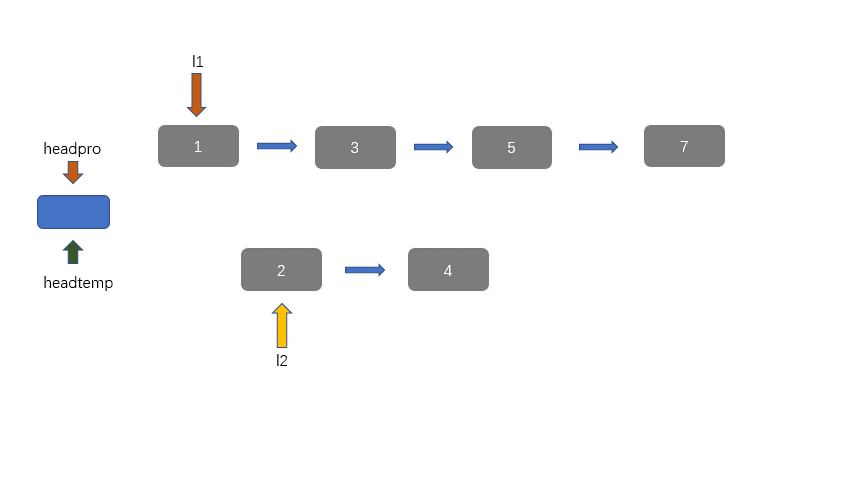mirror of
https://github.com/chefyuan/algorithm-base.git
synced 2024-11-14 16:13:39 +00:00
5.5 KiB
5.5 KiB
如果阅读时,发现错误,或者动画不可以显示的问题可以添加我微信好友 tan45du_one ,备注 github + 题目 + 问题 向我反馈
感谢支持,该仓库会一直维护,希望对各位有一丢丢帮助。
另外希望手机阅读的同学可以来我的 公众号:袁厨的算法小屋 两个平台同步,想要和题友一起刷题,互相监督的同学,可以在我的小屋点击刷题小队进入。
剑指 Offer 25. 合并两个排序的链表
将两个升序链表合并为一个新的 升序 链表并返回。新链表是通过拼接给定的两个链表的所有节点组成的。
示例:
输入:1->2->4, 1->3->4
输出:1->1->2->3->4->4
今天的题目思路很简单,但是一遍 AC 也是不容易的。链表大部分题目考察的都是考生代码的完整性和鲁棒性,所以有些题目我们看着思路很简单,但是想直接通过还是需要下一翻工夫的,所以建议大家将所有链表的题目都自己写一下。实在没有时间做的同学,可以自己在脑子里打一遍代码,想清每一行代码的作用。
迭代法:
因为我们有两个升序链表,我们需要将其合并,那么我们需要创建一个新节点 headpre,然后我们利用双指针思想,每个链表放置一个指针,然后进行遍历并对比当前指针指向的值。然后 headpre.next 指向较小值的那个节点,不断迭代,直至到达某一有序链表底部,此时一个链表遍历完成,然后我们将未完全遍历的链表接在我们接在合并链表之后即可。
这是我们迭代做法,另外这个题目还有一个递归方法,目前先不写,等链表掌握差不多的时候会单独写一篇关于递归的文章,也算是为树的题目做铺垫。
动图讲解:
题目代码
Java Code:
class Solution {
public ListNode mergeTwoLists(ListNode l1, ListNode l2) {
ListNode headpro = new ListNode(-1);
ListNode headtemp = headpro;
while (l1 != null && l2 != null) {
//接上大的那个
if (l1.val >= l2.val) {
headpro.next = l2;
l2 = l2.next;
}
else {
headpro.next = l1;
l1 = l1.next;
}
headpro = headpro.next;
}
headpro.next = l1 != null ? l1:l2;
return headtemp.next;
}
}
C++ Code:
class Solution {
public:
ListNode* mergeTwoLists(ListNode* l1, ListNode* l2) {
ListNode * headpro = new ListNode(-1);
ListNode * headtemp = headpro;
while (l1 != nullptr && l2 != nullptr) {
//接上大的那个
if (l1->val >= l2->val) {
headpro->next = l2;
l2 = l2->next;
}
else {
headpro->next = l1;
l1 = l1->next;
}
headpro = headpro->next;
}
headpro->next = l1 != nullptr ? l1: l2;
return headtemp->next;
}
};
JS Code:
var mergeTwoLists = function (l1, l2) {
let headpro = new ListNode(-1);
let headtemp = headpro;
while (l1 && l2) {
//接上大的那个
if (l1.val >= l2.val) {
headpro.next = l2;
l2 = l2.next;
} else {
headpro.next = l1;
l1 = l1.next;
}
headpro = headpro.next;
}
headpro.next = l1 != null ? l1 : l2;
return headtemp.next;
};
Python Code:
class Solution:
def mergeTwoLists(self, l1: ListNode, l2: ListNode) -> ListNode:
headpro = ListNode(-1)
headtemp = headpro
while l1 and l2:
# 接上大的那个
if l1.val >= l2.val:
headpro.next = l2
l2 = l2.next
else:
headpro.next = l1
l1 = l1.next
headpro = headpro.next
headpro.next = l1 if l1 is not None else l2
return headtemp.next
Swift Code:
class Solution {
func mergeTwoLists(_ l1: ListNode?, _ l2: ListNode?) -> ListNode? {
var l1 = l1, l2 = l2
var headpro: ListNode? = ListNode(-1)
var headtemp = headpro
while l1 != nil && l2 != nil {
//接上大的那个
if l1!.val >= l2!.val {
headpro?.next = l2
l2 = l2!.next
} else {
headpro?.next = l1
l1 = l1!.next
}
headpro = headpro?.next
}
headpro?.next = l1 != nil ? l1 : l2
return headtemp?.next
}
}
Go Code:
func mergeTwoLists(l1 *ListNode, l2 *ListNode) *ListNode {
root := &ListNode{}
node := root
for l1 != nil && l2 != nil {
if l1.Val < l2.Val {
node.Next = l1
l1 = l1.Next
} else {
node.Next = l2
l2 = l2.Next
}
node = node.Next
}
// node接上l1或l2剩下的节点
if l1 != nil {
node.Next = l1
} else {
node.Next = l2
}
return root.Next
}
